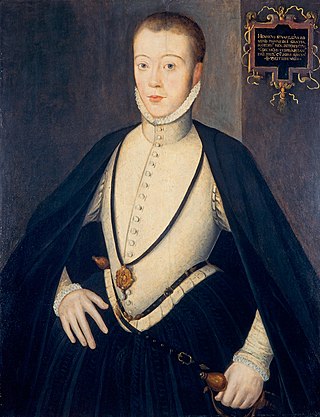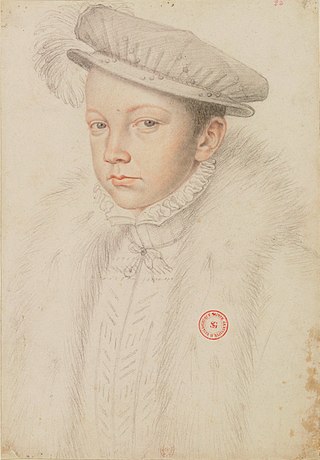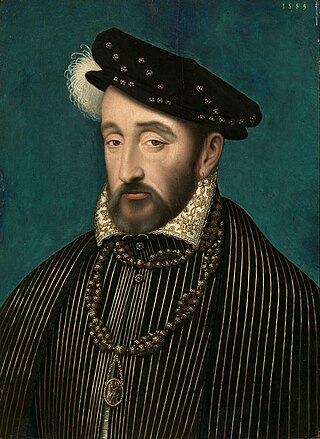| |||||
| Decades: | |||||
|---|---|---|---|---|---|
| See also: | Other events of 1548 History of France • Timeline • Years | ||||
Events from the year 1548 in France
| |||||
| Decades: | |||||
|---|---|---|---|---|---|
| See also: | Other events of 1548 History of France • Timeline • Years | ||||
Events from the year 1548 in France

Mary, Queen of Scots, also known as Mary Stuart or Mary I of Scotland, was Queen of Scotland from 14 December 1542 until her forced abdication in 1567.

Year 1568 (MDLXVIII) was a leap year starting on Thursday of the Julian calendar.

Year 1567 (MDLXVII) was a common year starting on Wednesday of the Julian calendar.
Mary, Queen of Scots (1542–1587), was queen regnant of Scotland and queen consort of France.

Henry Stuart, Lord Darnley, was an English nobleman who was the second husband of Mary, Queen of Scots, and the father of James VI of Scotland and I of England. Through his parents, he had claims to both the Scottish and English thrones, and from his marriage in 1565 he was king consort of Scotland. Less than a year after the birth of his son, Darnley was murdered at Kirk o' Field in 1567. Many contemporary narratives describing his life and death refer to him as simply Lord Darnley, his title as heir apparent to the Earldom of Lennox.

James Hepburn, 1st Duke of Orkney and 4th Earl of Bothwell, better known simply as Lord Bothwell, was a prominent Scottish nobleman. He was known for his marriage to Mary, Queen of Scots, as her third and final husband. He was accused of the murder of Mary's second husband, Henry Stuart, Lord Darnley, a charge of which he was acquitted. His marriage to Mary was controversial and divided the country; when he fled the growing rebellion to Norway, he was arrested and lived the rest of his life imprisoned in Denmark.

Francis II was King of France from 1559 to 1560. He was also King consort of Scotland as a result of his marriage to Mary, Queen of Scots, from 1558 until his death in 1560.

Mary of Guise, also called Mary of Lorraine, was a French noblewoman of the House of Guise, a cadet branch of the House of Lorraine and one of the most powerful families in France. She was Queen consort of Scotland from 1538 until 1542, as the second wife of King James V. As the mother of Mary, Queen of Scots, she was a key figure in the political and religious upheaval that marked mid-16th-century Scotland, ruling the kingdom as Queen regent on behalf of her daughter from 1554 until her death in 1560.

Henry II was King of France from 31 March 1547 until his death in 1559. The second son of Francis I and Duchess Claude of Brittany, he became Dauphin of France upon the death of his elder brother Francis in 1536.
A prince consort is the husband of a monarch who is not a monarch in his own right. In recognition of his status, a prince consort may be given a formal title, such as prince. Some monarchies use the title of king consort for the same role.

Mary, Queen of Scots is a 1971 biographical film based on the life of Mary Stuart, Queen of Scotland, written by John Hale and directed by Charles Jarrott. The cast was led by Vanessa Redgrave as the title character and Glenda Jackson as Elizabeth I. Jackson had previously played the part of Elizabeth in the BBC TV drama Elizabeth R, screened in February and March 1971, the first episode of which was also written by Hale.

The House of Stuart, originally spelt Stewart, was a royal house of Scotland, England, Ireland and later Great Britain. The family name comes from the office of High Steward of Scotland, which had been held by the family progenitor Walter fitz Alan. The name Stewart and variations had become established as a family name by the time of his grandson Walter Stewart. The first monarch of the Stewart line was Robert II, whose male-line descendants were kings and queens in Scotland from 1371, and of England, Ireland and Great Britain from 1603, until 1714. Mary, Queen of Scots, was brought up in France where she adopted the French spelling of the name Stuart.
Mary Stuart or Mary Stewart may refer to:
The Treaty of Edinburgh was a treaty drawn up on 5 July 1560 between the Commissioners of Queen Elizabeth I of England with the assent of the Scottish Lords of the Congregation, and the French representatives of King Francis II of France to formally conclude the siege of Leith and replace the Auld Alliance with France with a new Anglo-Scottish accord, while maintaining the peace between England and France agreed by the Treaty of Cateau-Cambrésis.

The Anglo-Scottish Wars comprise the various battles which continued to be fought between the Kingdom of England and the Kingdom of Scotland from the time of the Wars of Independence in the early 14th century through to the latter years of the 16th century.
Mary Fleming was a Scottish noblewoman and childhood companion and cousin of Mary, Queen of Scots. She and three other ladies-in-waiting were collectively known as "The Four Marys". A granddaughter of James IV of Scotland, she married the queen's renowned secretary, Sir William Maitland of Lethington.

Janet Stewart, Lady Fleming, called la Belle Écossaise, was a Scottish courtier. She was an illegitimate daughter of King James IV of Scotland who served as governess to her half-niece Mary, Queen of Scots. Janet was briefly a mistress of King Henry II of France, by whom she had a legitimated son: Henri d'Angoulême. Her daughter, Mary Fleming, was one of the young queen's "Four Marys".

The Palace of Holyroodhouse, commonly referred to as Holyrood Palace or Holyroodhouse, is the official residence of the British monarch in Scotland. Located at the bottom of the Royal Mile in Edinburgh, at the opposite end to Edinburgh Castle, Holyroodhouse has served as the principal royal residence in Scotland since the 16th century, and is a setting for state occasions and official entertaining.
Events from the year 1560 in France.

Mary Queen of Scots is a 2018 historical drama film directed by Josie Rourke and with a screenplay by Beau Willimon based on John Guy's 2004 biography Queen of Scots: The True Life of Mary Stuart. The film stars Saoirse Ronan as Mary, Queen of Scots, and Margot Robbie as her cousin Queen Elizabeth I. Jack Lowden, Joe Alwyn, David Tennant, and Guy Pearce also star in supporting roles.